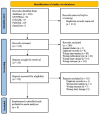Heterogeneous effects of eccentric training and nordic hamstring exercise on the biceps femoris fascicle length based on ultrasound assessment and extrapolation methods: A systematic review of randomised controlled trials with meta-analyses
- PMID: 34752499
- PMCID: PMC8577763
- DOI: 10.1371/journal.pone.0259821
Heterogeneous effects of eccentric training and nordic hamstring exercise on the biceps femoris fascicle length based on ultrasound assessment and extrapolation methods: A systematic review of randomised controlled trials with meta-analyses
Abstract
Objective: To systematically review the effects of eccentric training based on biceps femoris fascicle length using ultrasound assessment and extrapolation methods.
Design: Systematic review and meta-analysis of randomised controlled trials.
Data sources: CENTRAL, CINAHL Plus with full text, PubMed and OpenGrey databases were searched on 6 July 2021.
Eligibility criteria for selecting studies: Randomised controlled trials (RCTs) lasting at least four weeks and presenting data about biceps femoris (BF) fascicle length (FL) as an outcome.
Method: Searching databases, screening studies, performing risk of bias assessments and determining the level of evidence (LoE) for each meta-analysis were applied during the study. PRISMA 2020 statement and Cochrane Handbook for Systematic Reviews of Interventions were used as the guidelines of this systematic review.
Results: Eight randomised controlled trials included in meta-analyses. Based on the very low and low LoE, eccentric training has small (g = 0.29, 95% CI [-0.26, 0.85]), moderate (g = 0.72, 95% CI [0.17, 1.28]) and large (g = 2.20, 95% CI [0.99, 3.41]) effect sizes (ES) based on manual linear extrapolation (MLE), panoramic ultrasound scanning and trigonometric equation methods, respectively. Similarly, Nordic hamstring exercise (NHE) has small (g = 0.23 [-1.02, 1.47]), small (g = 0.38, 95% CI [-0.50, 1.27]) and large (g = 1.98, 95% CI [0.52, 3.44]) ES based on the MLE, panoramic ultrasound scanning and trigonometric equation methods, respectively.
Conclusion: ES of eccentric training, including NHE, vary between the MLE, panoramic ultrasound scanning, and equation methods. The relevant scientific community should have a consensus on measurement standards of the BF FL measurements. Further studies can be conducted to compare the effects of eccentric training based on the ultrasound assessment and extrapolation methods.
Conflict of interest statement
Gokhan Yagiz, Esedullah Akaras, Hans-Peter Kubis and Julian Andrew Owen declare that they have no conflict of interest in this systematic review’s content.
Figures













References
Publication types
MeSH terms
LinkOut - more resources
Full Text Sources
Medical
Miscellaneous

